Last Updated on January 21, 2022
After completing your app development process, you might think that, next, it’s the time to sit back and watch your app’s journey. But, let you know that doing this will not bestow success to your mobile app.
We already know that mobile app development costs a lot of money and also demands time. So, don’t allow your hard work to get wasted. Your mobile app may be ready for launch, but there’s always room left for improvement. So, it’s better that you should track different metrics of your mobile app to check out the performance of your mobile app.
Today, in this post, we will talk about mobile app metrics that you should keep track of while measuring your app’s performance. So, if your app is in the pre-launch phase of development or has just launched an app, this post would be helpful for you.
What Are Mobile App Metrics?
Mobile app metrics let you know about your app’s performance and keep you well-informed about your users’ retention, conversion, engagement, and revenue generation caliber.
So, before you start with your latest app idea, let us inform you that the metrics we have mentioned below may not apply to your online business. That’s why firstly, have an idea of the metrics you choose and then consider tracking them.
Why Are Mobile Apps Metrics Important?
Without mobile app metrics, the brands would find themselves unable to know whether their apps are failing or succeeding. Companies that fail to have precise mobile app metrics are targeted to depend on broad indicators, like total downloads or total revenues. Such top-level indicators make the companies witness the problems and take action accordingly.
Essential Mobile App Metrics
There are varied types of mobile app metrics that you may consider to track the performance of your mobile app. Let’s check out a few.
| App Metrics To Track |
KPI | Tracks |
|---|---|---|
| Acquisition | New Downloads | The number of downloads: monthly, weekly, daily to track your app’s growth. |
| Download Attributes | The channels from where new users come for optimizing marketing expenses and enhancing ROI. | |
| Retention | Day 3 & Day 7 retention post your app launch | The number of users who are using your app constantly for three and seven days post its launch to check if users find your app valuable. |
| Monthly and weekly retention cohorts | How long every cohort stays active in your mobile app to check which in-app behavior holds positive or negative effects on retention. | |
| Activation | Activation rate | App downloads’ percentage that launch the mobile app and 85% and more is good, 84% and less fix the issue. |
| Uninstall | Weekly/daily uninstalls | Number of uninstalls to get a result of your app’s growth. |
| Churn Rate | (Users at the start – users at the end of a period)/ users at the beginning to forecast your app’s growth and revenue accurately. | |
| Engagement | DAU/MAU | The number of active users on a given month or day to check if your app keeps users engaged. |
| Average session length and frequency | How often the users are rolling out your app, and how long an average session lasts to check the effectiveness of your app engagement campaign and the quality of your user experience. | |
| Reachability | Click-through rates | The percentage of users who click push notifications, email links, and in-app notifications. |
App Performance Metrics
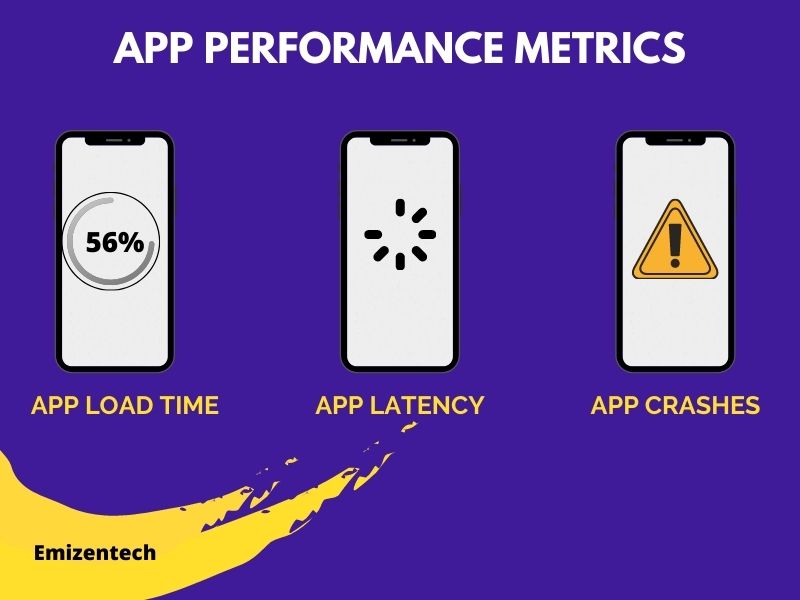 App performance metrics include varied ways that assist in measuring the performance of the mobile app.
App performance metrics include varied ways that assist in measuring the performance of the mobile app.
App Latency
The amount of time an app demands to make a request and, in turn, get a response from the Application Programming Interface (API) is app latency. Ideally, it’s expected to be as little as possible. However, zero latency is like a dream for the predictable future.
App Load Time
If you don’t want your mobile app users to abandon your app without witnessing your offerings, you should take care of app load time. The users like the mobile apps with swift processing and seamless navigation. And, it takes a long time to load, your app is going to suffer.
Also Read: Tech Stack For Developing A Mobile App
App Crashes
Just like the app load time, app crashes are one more massive blockage in the way of your mobile app towards success. App crashes the abrupt shutting down of an app. Moreover, higher app load time is also a minor issue for app crash issues as the users need to begin everything from the start to accomplish their objectives.
So, you need to track your mobile app constantly crashes, precisely the following:
- How often does your app crash?
- How many times in a day does it crash while in use?
- How many users get affected when your app crashes?
- What were your users doing while the crashes occurred?
App Metrics for Engagement
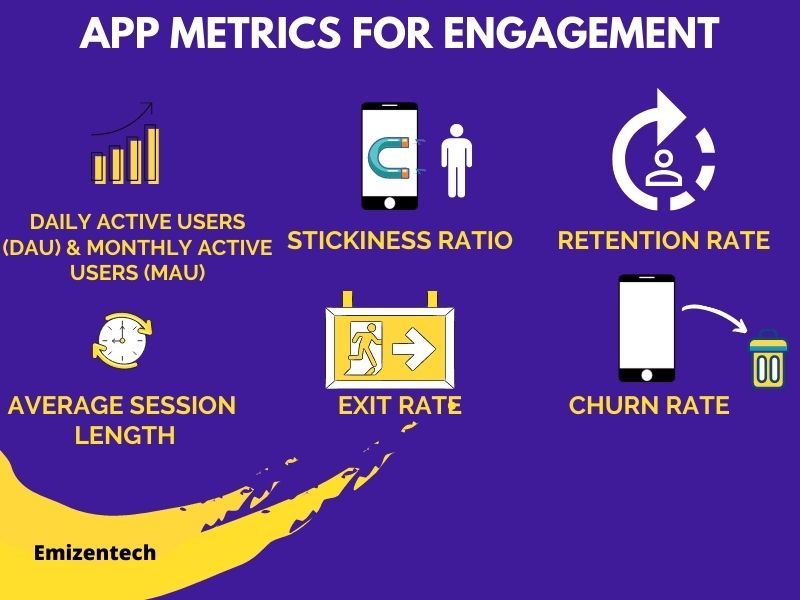 This app metric measures your app’s effectiveness and how much it’s getting connected with the users.
This app metric measures your app’s effectiveness and how much it’s getting connected with the users.
Daily Active Users (DAU) & Monthly Active Users (MAU)
These mobile app metrics will assist you in knowing how useful or engaging your mobile app is to the downloaders of your app.
The number of unique users who come to your app daily is Daily Active Users (DAU), while the number of unique users who come to your app in a month is Monthly Active Users (MAU).
Both the mobile app metrics, DAU and MAU, should catch up with the higher path; otherwise, you would need to use tools like push notifications and others to attract your customers back. The figures you get through these metrics would be best to craft limited-time and conversion-targeted campaigns.
How to calculate DAU / MAU?
To calculate these, you need to check out how many users conduct an action on your app on a monthly or daily basis. This numeric value is your MAU or DAU
Stickiness Ratio
One of the essential app metrics, the Stickiness Ratio, lets you know how much value your app users derive from your mobile app, which is generally measured over months. This calculation includes both DAUs and MAUs. Resultantly, a higher percentage would indicate that more people found your mobile app engaging and valuable.
How to calculate Stickiness?
Stickiness Ratio = Daily Active Users (DAU) / Monthly Active Users (MAU) x 100
Churn Rate
A rate at which your mobile app users uninstall your app or cancel it or downgrade the subscriptions. The churn rate is terrible on its part, but it becomes worse when your most valuable, revenue-generating app users churn. It lay an adverse impact on the whole unit economics of your online business.
How to calculate Churn Rate?
Churn Rate = Users at the start of the period – users at the end of the period/users at the beginning of the period
Average Session Length
The amount of time every user spends on your mobile app, on average, is known as Average Session Length. However, it’s not a universal mobile app metric, but its applicability relies on the industry you operate. It offers you an idea of how valuable your users find your in-app content. That’s why it’s worth tracking this metric. Later, if they don’t find your app, you need to perform some A/B mobile application testing to know your user preferences.
How to calculate Average Session Length?
Average Session Length = Total time duration of all sessions (in seconds) during a defined time frame / total number of sessions through that same time frame.
Retention Rate
This mobile app metric allows you to know the percentage of customers that you are retaining. Resultantly, you will become capable of seeing the number of customers you are losing to churn.
You may calculate the retention rate by comparing a group of users in the recent timeframe with those same app users in the past timeframe. You may also calculate this app metric using your app download or first login.
How to calculate Retention Rate?
Retention Rate = (Number of users at the end of a time - Number of users came during this period) / Number of users at the start of the time X 100
Exit Rate
Usually, we get confused with Bounce Rate; the Exit Rate is much different from it. Bounce rate calculates the users abandoning a platform without getting engaged with the content. Whereas, exit rate emerges with the same drop-off screen from where the users usually take the exit. When it comes to a mobile app, we should target the Exit Rate.
How to Calculate Exit Rate?
Exit Rate = Total number of Visits to a screen/total number of drop-offs or exits from that particular screen.
Vanity Metrics
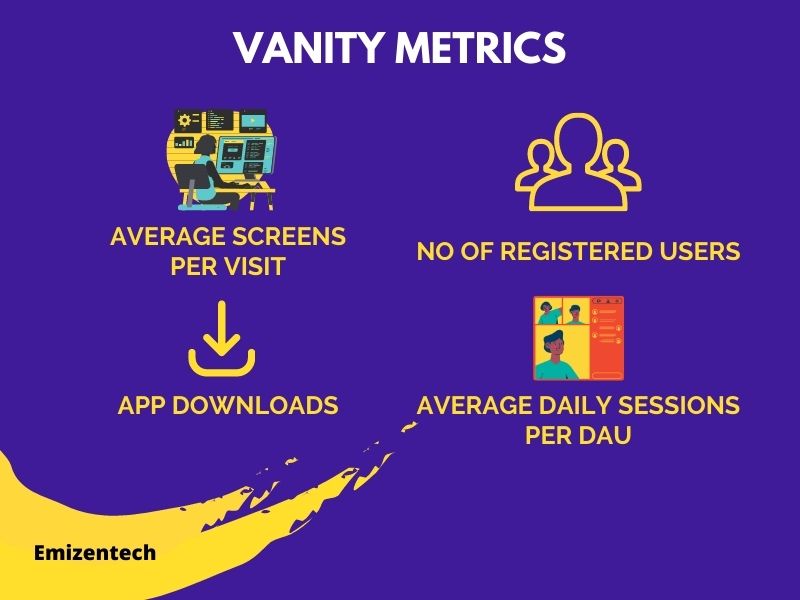 Any app metric that doesn’t affect your profit of either increasing your engagement rates or generating revenues may be considered a vanity metric.
Any app metric that doesn’t affect your profit of either increasing your engagement rates or generating revenues may be considered a vanity metric.
App Downloads
Mirroring the number of registered users is one more metric known as app downloads. By extracting the app downloads, we can’t dig out any specific result as app downloads don’t emerge with a clear picture of the usefulness or popularity of an app.
So, here you can track the sources from where your users are coming to download your mobile app. It will let you know about the most efficient channels from where your app users are coming. You can even try more to improve the lagging channels.
Average Screens Per Visit
This app metric indicates the engagement levels. The more screens a user watches, the greater their engagement level on your app.
It is a vanity metric as suppose if a user visits ten screens on your app but doesn’t buy anything, you still have to achieve more. Also, the average number of screens per visit can offer you a very hollow image if you fail to track the on-screen time, as a user may be just switching through the screens.
Number of Registered Users
To get it, first, open your Play store or app store on your mobile phone and check out the descriptions of the apps. As there are over 60% of mobile app’s descriptions, one common thing you should notice is that when people say they have X00,000 registered users, it includes active and inactive users.
For example, if there are 500,000 registered users, the MAU is just 50. Then, what’s the benefit of having a high registration number? It also states that you have been targeting more on the acquisition and less on retaining users.
Average Daily Sessions Per DAU
There is an issue with this mobile app metric. First, it applies to a minimal number of industries, and second, like the other vanity metrics, it doesn’t impact your revenue.
When it comes to definition, the Average Daily Sessions Per DAU reveals the number of times your daily active users open your mobile app. It points – how your mobile users are engaged with your application. But, let you know that this applies to a few industries only, like social media apps.
App Metrics for Conversion
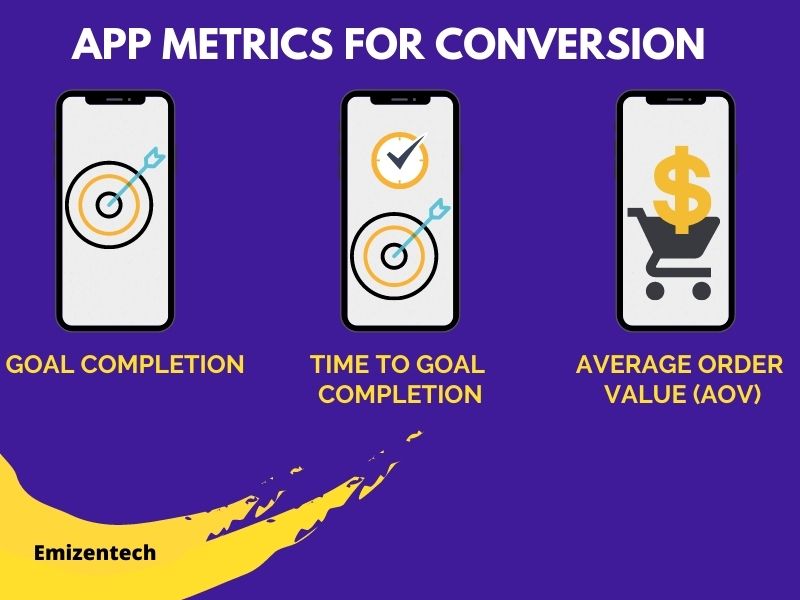 This app metric measures how many people install your application post landing on your App Store Page.
This app metric measures how many people install your application post landing on your App Store Page.
Goal Completion
One of the essential metrics, goal completion, is when we need to evaluate conversions, be it’s for your mobile app or website. Famed by Google, goal completion is utilized to track anything, in fact, everything. It indicates your users are interacting with your platform and are also deriving the actual value from it.
Using the goal completion, you can identify the below crucial issues:
- Identify the checkpoints that experience various drop-offs
- Goals that demand most of the time to complete
- Goals that have notable obstructions and more.
Be sure that your goals should always affect your revenues, either in the short or long run.
Average Order Value (AOV)
The amount of money customers spent on all the orders they place on your mobile app is the Average Order Value (AOV). The AOV may help you evaluate your marketing and pricing strategies and is the metric that directly impacts your revenue.
An increasing AOV is the best way to counterbalance your customer acquisition costs, enhance your profit margins, and improve your total revenue without even putting more stress on attracting more customers to boost revenue.
How to calculate AOV?
Average Order Value = Total Revenue / No. of Orders.
Time to Goal Completion
This mobile app metric will let you know if your app users have more time than needed to accomplish your desired actions and meet the goals. It will pose a question on all the possibilities that are the chief reasons behind the inconvenience.
You should understand the users’ intent to visit your platform and make sure they don’t get distracted before purchasing.
Also Read: Complete Guide To Building An eCommerce Mobile App
App Metrics for Acquisition
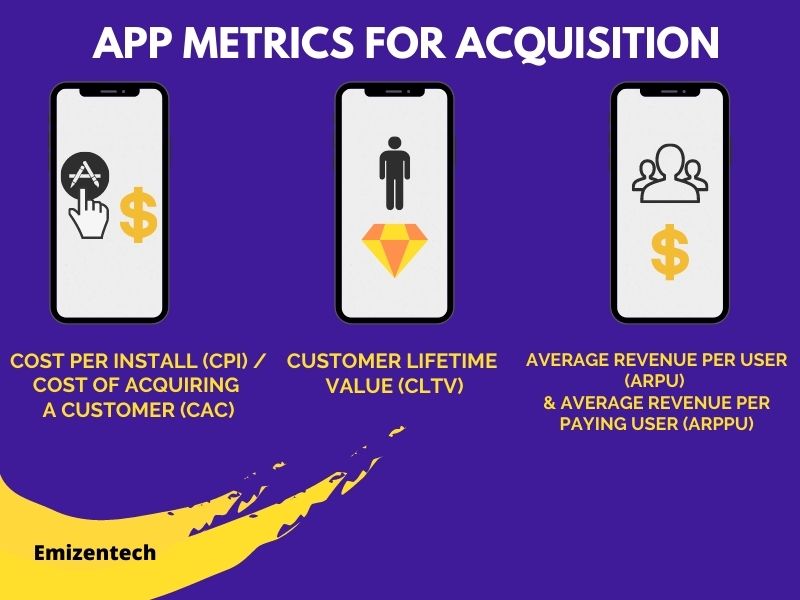
Cost Per Install (CPI) / Cost of Acquiring a Customer (CAC)
It measures how expensive it’s for you to attract your users. A low CPI is considered as good. Besides, it will indicate that you are losing every new customer if it goes beyond the customer’s lifetime value (LTV). CPA is usually measured by the total cost of the marketing campaigns that help in acquiring new users. But, it needs to consider a fraction of your product development costs and your operational cost that enable the acquisition.
How to calculate CPI?
CPI = Total Marketing Cost / Total Acquired Users
Customer Lifetime Value (CLTV)
Post you acquire customers, ahead of an essential metric, Customer Lifetime Value (CLTV) determines how much cost you can anticipate making from your average customer until they uninstall your application.
Your CLTV will be an indicator to understand if you are spending more to acquire your users. In that case, you should perform substantial efforts dedicated to boosting your CLTV.
How to calculate CLTV?
CLTV = Average Value of Conversion x Average Number of Conversions over a Time period x Average Customer Life Time
Average Revenue Per User (ARPU) & Average Revenue Per Paying User (ARPPU)
This app metric is critical that helps in understanding if you meet your monthly revenue targets. In case if not, it will let you know what sort of gap is there that you need to resolve. ARPU is the amount of revenue your average user generates for you.
Getting deeper, ARPU and CLTV look similar, where ARPU lets you know the average revenue your users help in generating, and CLTV also enables you to understand the same. Still, for the time being, they are your customers.
There is not a significant difference between ARPU and CLTV. With ARPU, you can’t predict the whole amount of revenue the user is expected to generate for you in the entire lifetime, which CLTV does for you.
How to calculate ARPU?
ARPU = Lifetime Revenue / No. of Lifetime Users
NOTE: KPI & Metrics are Different – Don’t Mix Up
Key Performance Indicators (KPI) are the measurable values that reveal how effective you are at attaining business targets. In contrast, metrics are different as they track the status of a particular business process.
Wrapping Up
Tracking such essential mobile app performance metrics will offer you a clearer picture of your marketing ROI and growth. Moreover, these metrics will assist you in identifying where you can enhance the user experience to develop an app that users love.
We hope that this post may have helped you understand the significance of deciding metrics to track before launching your app in the market. Also, if you ever need professional help then get in touch with us as Emizentech is a leading app development company with experience & a great team.





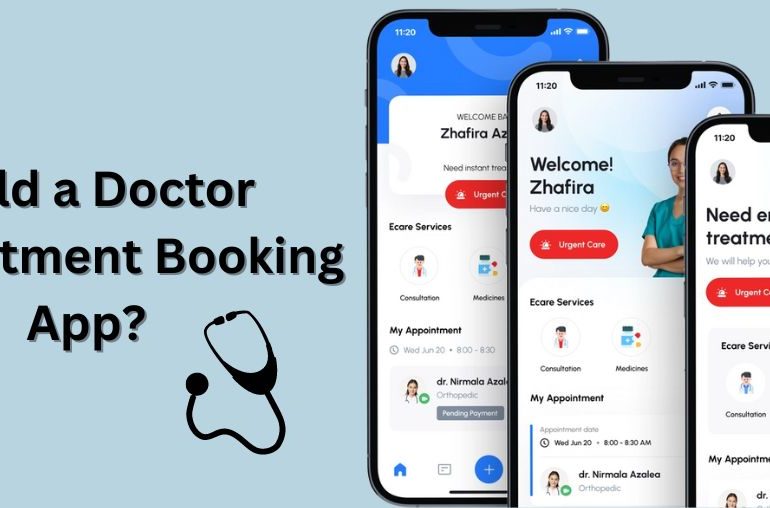
 USA
USA UK
UK Singapore
Singapore